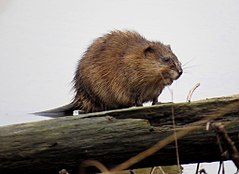Piżmak
| Ondatra[1] | |||
| Link, 1795[2] | |||
 Przedstawiciel rodzaju – piżmak amerykański (Ondatra zibethicus) | |||
| Systematyka | |||
| Domena | |||
|---|---|---|---|
| Królestwo | |||
| Typ | |||
| Podtyp | |||
| Gromada | |||
| Podgromada | |||
| Rząd | |||
| Podrząd | |||
| Infrarząd | |||
| Nadrodzina | |||
| Rodzina | |||
| Podrodzina | |||
| Plemię | Ondatrini | ||
| Rodzaj | piżmak | ||
| Typ nomenklatoryczny | |||
Castor zibethicus Linnaeus, 1766 | |||
| Synonimy | |||
| Gatunki | |||
| |||
Piżmak[9] (Ondatra) – rodzaj ssaka z podrodziny karczowników (Arvicolinae) w obrębie rodziny chomikowatych (Cricetidae).
Zasięg występowania
Rodzaj obejmuje jeden żyjący współcześnie gatunek występujący w Ameryce Północnej[10][11].
Morfologia
Długość ciała (bez ogona) 256–299 mm, długość ogona 200–254 mm; masa ciała 700–1800 g[12].
Systematyka
Etymologia
- Ondatra: hurońska nazwa ondatra lub ondathra dla piżmaka[13].
- Fiber: łac. fiber „bóbr” (por. nowołac. fiber „nurek, pływak”)[14]. Gatunek typowy: Castor zibethicus Linnaeus, 1766.
- Mussascus: ang. mussascus „piżmak”, od aben. moskwas „piżmak”[15]; nowa nazwa dla Odantra Link, 1795 i Fiber G. Cuvier, 1800.
- Simotes: gr. σιμοτης simotēs, σιμοτητος simotētos „zadarty kształt nosa”, od σιμος simos „zadartonosy, mający zadarty nos”[16]; nowa nazwa dla Fiber G. Cuvier, 1800.
- Moschomys: gr. μοσχος moskhos „piżmo”, od pers. مشک mušk „piżmo”; μυς mus, μυος muos „mysz”[17]; nowa nazwa dla Odantra Link, 1795.
- Pliopotamys: gr. przedrostek pleio pleio- „plio-” (tj. z pliocenu), od πλειων pleiōn „więcej”, forma wyższa od πολυς polus „dużo”[18]; ποταμος potamos „rzeka”[19]; μυς mus, μυoς muos „mysz”[20]. Gatunek typowy: †Pliopotamys meadensis Hibbard, 1937.
- Neondatra: gr. νεος neos „nowy”[21]; rodzaj Odantra Link, 1795 (piżmak). Gatunek typowy: †Neondatra kansasensis Hibbard, 1937 (= †Pliopotamys meadensis Hibbard, 1937).
Podział systematyczny
Do rodzaju należą jeden występujący współcześnie gatunek[10][9]:
- Ondatra zibethicus (Linnaeus, 1766) – piżmak amerykański
oraz gatunki wymarłe[22]:
- Ondatra annectens (Brown, 1908)
- Ondatra idahoensis R.W. Wilson, 1933
- Ondatra meadensis (Hibbard, 1937)
- Ondatra minor R.W. Wilson, 1933
Przypisy
- ↑ Ondatra, [w:] Integrated Taxonomic Information System [online] (ang.).
- ↑ J.H.F. Link: Beyträge zur Naturgeschichte. Zweytes Stück. Ueber die Lebenskräfte in naturhistorischer Rücksich, und die Classification der Säugethiere. Rostock: K.C. Stiller, 1795, s. 76. (niem.).
- ↑ G. Cuvier: Lecons d’anatomie comparée. T. 1. Paris: Baudouin, 1800, s. tab. 1. (fr.).
- ↑ L. Oken: Lehrbuch der Naturgeschichte. T. 3. Cz. 2. Jena: August Schmid, 1816, s. 886. (niem.).
- ↑ J.G. Fisher von Waldheim. De systemate Mammalium. „Mémoires de la Société impériale des naturalistes de Moscou”. 5, s. 444, 1817. (łac.).
- ↑ G.J. Billberg: Synopsis Faunae Scandinaviae. T. 1. Cz. 1: Mammalia. Holmiae: Ex officina typogr. Caroli Deleen, 1827, s. Tab. A. (łac.).
- ↑ Hibbard 1938 ↓, s. 249.
- ↑ Hibbard 1938 ↓, s. 251.
- ↑ a b Nazwy polskie za: W. Cichocki, A. Ważna, J. Cichocki, E. Rajska-Jurgiel, A. Jasiński & W. Bogdanowicz: Polskie nazewnictwo ssaków świata. Warszawa: Muzeum i Instytut Zoologii PAN, 2015, s. 239. ISBN 978-83-88147-15-9. (pol. • ang.).
- ↑ a b C.J. Burgin, D.E. Wilson, R.A. Mittermeier, A.B. Rylands, T.E. Lacher & W. Sechrest: Illustrated Checklist of the Mammals of the World. Cz. 1: Monotremata to Rodentia. Barcelona: Lynx Edicions, 2020, s. 342. ISBN 978-84-16728-34-3. (ang.).
- ↑ D.E. Wilson & D.M. Reeder (redaktorzy): Genus Ondatra. [w:] Mammal Species of the World. A Taxonomic and Geographic Reference (Wyd. 3) [on-line]. Johns Hopkins University Press, 2005. [dostęp 2021-11-16].
- ↑ U. Pardiñas, P. Myers, L. León-Paniagua, N.O. Garza, J. Cook, B. Kryštufek, R. Haslauer, R. Bradley, G. Shenbrot & J. Patton. Opisy gatunków Cricetidae: U. Pardiñas, D. Ruelas, J. Brito, L. Bradley, R. Bradley, N.O. Garza, B. Kryštufek, J. Cook, E.C. Soto, J. Salazar-Bravo, G. Shenbrot, E. Chiquito, A. Percequillo, J. Prado, R. Haslauer, J. Patton & L. León-Paniagua: Family Cricetidae (True Hamsters, Voles, Lemmings and New World Rats and Mice). W: D.E. Wilson, R.A. Mittermeier & T.E. Lacher (redaktorzy): Handbook of the Mammals of the World. Cz. 7: Rodents II. Barcelona: Lynx Edicions, 2017, s. 289. ISBN 978-84-16728-04-6. (ang.).
- ↑ Palmer 1904 ↓, s. 475.
- ↑ Palmer 1904 ↓, s. 285.
- ↑ Mussascus (English). WordSense Dictionary. [dostęp 2021-11-16]. (ang.).
- ↑ Palmer 1904 ↓, s. 632.
- ↑ Palmer 1904 ↓, s. 433.
- ↑ Jaeger 1944 ↓, s. 178.
- ↑ Jaeger 1944 ↓, s. 183.
- ↑ Jaeger 1944 ↓, s. 141.
- ↑ Jaeger 1944 ↓, s. 145.
- ↑ J. Zijlstra: Ondatra. Hesperomys project. [dostęp 2021-11-15]. (ang.).
Bibliografia
- T.S. Palmer. Index Generum Mammalium: a List of the Genera and Families of Mammals. „North American Fauna”. 23, s. 1–984, 1904. (ang.).
- C.W. Hibbard. An Upper Pliocene fauna from Meade County, Kansas. „Transactions of the Kansas Academy of Science”. 40, s. 239–265, 1938. DOI: 10.2307/3625415. (ang.).
- E.C. Jaeger: Source-book of biological names and terms. Wyd. 1. Springfield: Charles C. Thomas, 1944, s. 1-256. (ang.).
Media użyte na tej stronie
Autor: (of code) -xfi-, Licencja: CC BY-SA 3.0
The Wikispecies logo created by Zephram Stark based on a concept design by Jeremykemp.
Now that spring has arrived, we've been seeing a lot of muskrat activity at Port Louisa National Wildlife Refuge in Iowa.
Photo by Jessica Bolser/USFWS.
